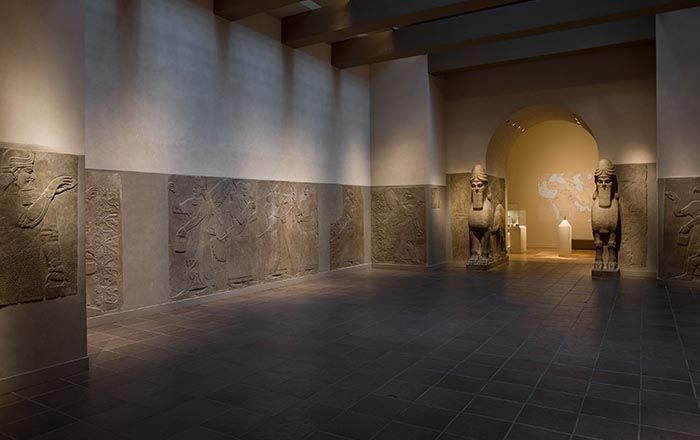Plaque carved in relief with kneeling figure
Not on view
This trapezoidal ivory plaque was found in a storage room in Fort Shalmaneser, a royal building at Nimrud that was used to store booty and tribute collected by the Assyrians while on military campaign. It depicts a male figure, barefoot and dressed in an Egyptian-style kilt and short wig. A diagonal element running from his waist across his right elbow may either be the end of a belt or the edge of a loose sleeve, but there is no neckline shown to suggest he is wearing a shirt. It is possible that the carver misunderstood this element, which appears more clearly on other carved ivories from Nimrud in the collection of the Metropolitan Museum such as 60.145.2. The figure kneels and bends his elbows, raising both hands palm outward towards the right. It is not clear what he faces; an L-shaped element preserved in the upper right corner of the plaque was likely connected with an image depicted on the adjoining plaque to the right. A raised plain border is partially preserved on the left and right sides. Carved ivory pieces such as this were widely used in the production of elite furniture and luxury objects during the early first millennium B.C., and could be overlaid with gold foil or inlaid to create a dazzling effect of gleaming surfaces and bright colors. This piece is one of many elaborately carved ivories with motifs adapted from Egyptian art that have been attributed to Phoenician workshops, as Phoenician art shows strong Egyptian influence. It was found with many other small trapezoidal plaques, suggesting that these pieces were originally fitted together in a hexagonal or octagonal ring that was wider at the bottom than the top. If equipped with bases and lids, these could have been used as boxes, or alternatively they could have served as stands for bowls or round-bottomed goblets.
Built by the Assyrian king Ashurnasirpal II, the palaces and storerooms of Nimrud housed thousands of pieces of carved ivory. Most of the ivories served as furniture inlays or small precious objects such as boxes. While some of them were carved in the same style as the large Assyrian reliefs lining the walls of the Northwest Palace, the majority of the ivories display images and styles related to the arts of North Syria and the Phoenician city-states. Phoenician style ivories are distinguished by their use of imagery related to Egyptian art, such as sphinxes and figures wearing pharaonic crowns, and the use of elaborate carving techniques such as openwork and colored glass inlay. North Syrian style ivories tend to depict stockier figures in more dynamic compositions, carved as solid plaques with fewer added decorative elements. However, some pieces do not fit easily into any of these three styles. Most of the ivories were probably collected by the Assyrian kings as tribute from vassal states, and as booty from conquered enemies, while some may have been manufactured in workshops at Nimrud. The ivory tusks that provided the raw material for these objects were almost certainly from African elephants, imported from lands south of Egypt, although elephants did inhabit several river valleys in Syria until they were hunted to extinction by the end of the eighth century B.C.
Due to rights restrictions, this image cannot be enlarged, viewed at full screen, or downloaded.
This artwork is meant to be viewed from right to left. Scroll left to view more.



